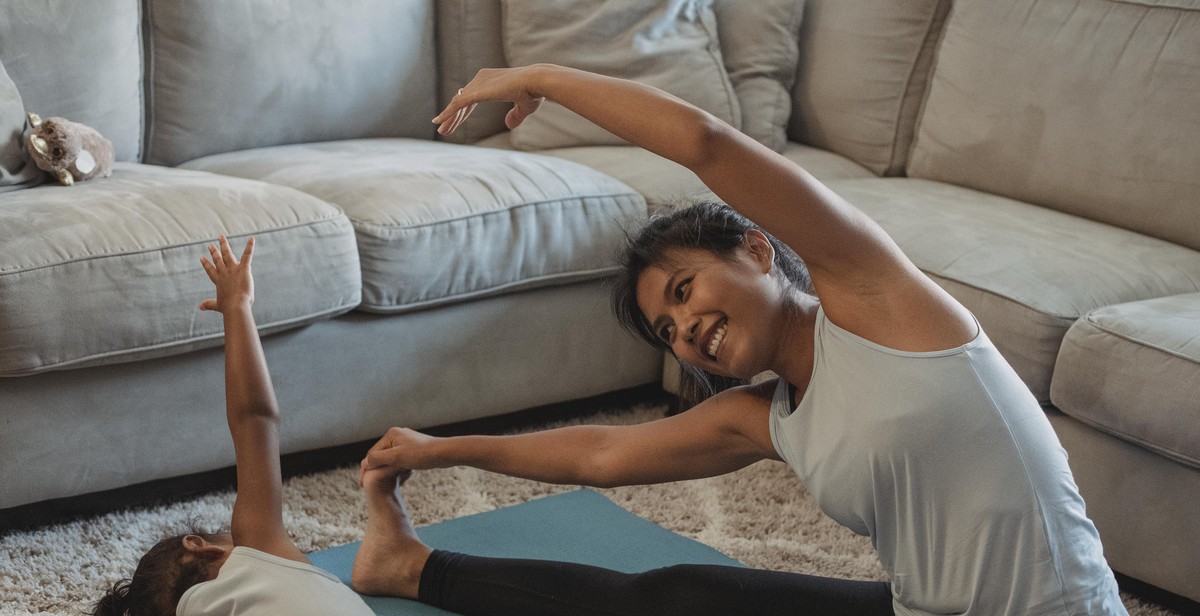Introduction
Aerial yoga is a unique form of yoga that involves performing traditional yoga poses with the support of a hammock or silk fabric suspended from the ceiling. It is a fun and challenging workout that combines elements of yoga, Pilates, and aerial acrobatics to improve flexibility, strength, and balance.
What is Aerial Yoga?
Aerial yoga, also known as anti-gravity yoga, is a type of yoga that uses a soft fabric hammock to support and suspend the body in the air. The hammock is adjustable and can be used to perform a variety of yoga poses, such as inversions, backbends, and twists. Aerial yoga is suitable for all levels, from beginners to advanced practitioners, and can be modified to accommodate individual needs and abilities.
Benefits of Aerial Yoga
Aerial yoga provides a range of physical and mental benefits, including improved flexibility, strength, balance, and posture. The use of the hammock also helps to decompress the spine, increase circulation, and reduce stress on the joints. In addition, aerial yoga can help to boost mood, reduce anxiety, and improve overall well-being.
- Improved flexibility
- Increased strength
- Better balance
- Improved posture
- Spinal decompression
- Increased circulation
- Reduced stress on joints
- Boosted mood
- Reduced anxiety
- Improved overall well-being
If you’re looking for a fun and challenging way to improve your flexibility and strength, aerial yoga may be just what you need. In the following sections, we will explore some of the key poses and techniques used in aerial yoga to help you get started on your journey to better health and wellness.
Improving Flexibility with Aerial Yoga
Aerial yoga is a unique and fun way to improve flexibility. It combines traditional yoga poses with the use of a hammock or aerial silk, which allows for deeper stretches and greater range of motion.
Stretching with Aerial Yoga
The hammock or aerial silk used in aerial yoga can support the body in various positions, making it easier to hold stretches for longer periods of time. This can lead to increased flexibility over time.
One of the benefits of aerial yoga is spinal decompression. The hammock can help to lengthen the spine and relieve tension in the back, which can lead to greater mobility and flexibility in the entire body.
Poses for Flexibility
There are several aerial yoga poses that can help to improve flexibility:
- Pigeon pose: This pose can help to open up the hips and stretch the glutes. To do this pose, sit in the hammock with one leg extended behind you and the other bent in front of you. Lean forward and rest your forehead on the hammock.
- Forward fold: This pose can help to stretch the hamstrings and lower back. To do this pose, sit in the hammock with your legs extended in front of you. Lean forward and rest your hands on the hammock.
- Backbend: This pose can help to open up the chest and stretch the shoulders. To do this pose, sit in the hammock with your hands holding onto the sides of the hammock. Lean back and lift your chest up towards the ceiling.
It is important to remember to listen to your body and not push yourself too far in any pose. Aerial yoga is meant to be a gentle and relaxing practice, so take your time and enjoy the process of improving your flexibility.
Conclusion
Incorporating aerial yoga into your fitness routine can be a great way to improve flexibility. The use of a hammock or aerial silk can support the body in various positions, allowing for deeper stretches and greater range of motion. By practicing aerial yoga regularly and incorporating poses specifically designed for flexibility, you can gradually increase your flexibility and enjoy the many benefits of this unique practice.

Building Strength with Aerial Yoga
Aerial yoga is not just about improving flexibility and balance; it also provides an excellent opportunity to build strength. By using the aerial hammock as a prop, you can perform bodyweight exercises that target specific muscle groups. Here are some ways aerial yoga can help you build strength:
Strength Training with Aerial Yoga
One of the best things about aerial yoga is that it allows you to perform strength training exercises without putting too much pressure on your joints. The hammock supports your body weight, which means you can do exercises that would be difficult or impossible to do on the ground.
Some of the most effective strength training exercises you can do with aerial yoga include pull-ups, push-ups, and squats. These exercises target your upper body, core, and lower body respectively, helping you to build overall strength and muscle mass.
Poses for Strength
There are several aerial yoga poses that are specifically designed to build strength. Here are some of the most effective ones:
- Forearm Stand: This pose requires a lot of upper body strength and is great for building core and shoulder strength.
- Pike: This pose targets your abs, arms, and shoulders, and is great for building overall upper body strength.
- Warrior I: This pose is great for building leg strength, as it targets your quads, hamstrings, and glutes.
- Backbend: This pose targets your back muscles and helps to improve posture and spinal flexibility.
By incorporating these poses into your aerial yoga practice, you can build strength and muscle mass in a fun and challenging way.
Conclusion
Building strength with aerial yoga is a great way to improve your overall fitness and health. By using the aerial hammock as a prop, you can perform bodyweight exercises that target specific muscle groups and help you build strength and muscle mass. Incorporate these poses into your aerial yoga practice and enjoy the benefits of a stronger, healthier body.

Combining Flexibility and Strength Training with Aerial Yoga
Aerial yoga is a unique form of yoga that involves performing traditional yoga poses while suspended in the air using a hammock. This type of yoga not only enhances flexibility but also promotes strength and balance. Combining flexibility and strength training is essential for overall fitness and well-being.
Flowing Between Poses
One of the primary benefits of aerial yoga is the ability to flow between poses seamlessly. The hammock provides support and stability, allowing practitioners to move with ease from one pose to another. This flowing movement helps to build strength and flexibility simultaneously. The more fluidly you can move between poses, the more control you have over your body, and the more you can challenge yourself.
Challenging Poses that Combine Strength and Flexibility
Aerial yoga offers a range of challenging poses that require both strength and flexibility. These poses include the Flying Pigeon, the Flying Splits, and the Flying Dragon. These poses require a combination of strength, balance, and flexibility to perform, making them an excellent workout for the entire body.
The Flying Pigeon pose, for example, requires the practitioner to balance on one leg while the other leg is extended behind them, with the foot hooked onto the hammock. This pose requires a great deal of core strength, balance, and flexibility in the hips and legs.
The Flying Splits pose involves the practitioner extending both legs out to the sides while suspended in the hammock. This pose requires a great deal of strength in the legs and core, as well as flexibility in the hips and hamstrings.
The Flying Dragon pose requires the practitioner to balance on one leg while the other leg is extended out to the side, with the foot hooked onto the hammock. This pose requires a great deal of core strength, balance, and flexibility in the hips and legs.
Conclusion
Combining flexibility and strength training is essential for overall fitness and well-being, and aerial yoga provides an excellent way to achieve this. By flowing between poses and challenging yourself with poses that require both strength and flexibility, you can improve your physical fitness and enhance your overall well-being.
Conclusion
Aerial yoga is a unique and fun way to improve both flexibility and strength. By incorporating the use of a hammock, aerial yoga allows you to deepen stretches and build muscle in ways that traditional yoga cannot. Whether you are a seasoned yogi or a beginner, aerial yoga can provide a challenging and rewarding workout.
Tips for Success
- Find a qualified instructor who can guide you through the proper technique and form.
- Start with beginner-level classes and gradually work your way up to more advanced poses.
- Listen to your body and don’t push yourself too hard. It’s important to respect your limits and avoid injury.
- Wear comfortable clothing that allows for a full range of motion.
- Stay hydrated and fuel your body with nutritious foods to support your practice.
Final Thoughts
Overall, aerial yoga is a fun and effective way to improve your physical health and well-being. By incorporating the use of a hammock, you can challenge yourself in new ways and achieve greater flexibility and strength. With the right instructor and a commitment to your practice, you can experience the many benefits of aerial yoga for yourself.
| Benefits of Aerial Yoga | Benefits of Traditional Yoga |
|---|---|
| Improved flexibility and range of motion | Improved balance and coordination |
| Increased strength and muscle tone | Reduced stress and anxiety |
| Improved posture and alignment | Improved cardiovascular health |
